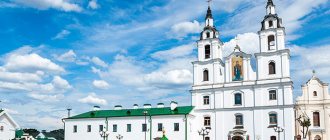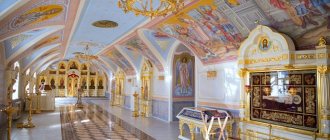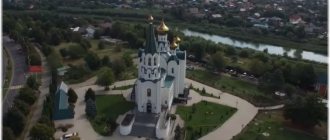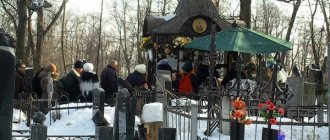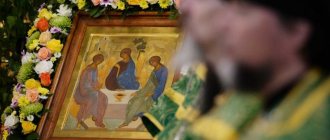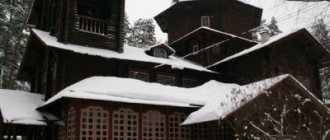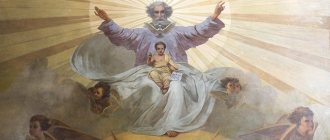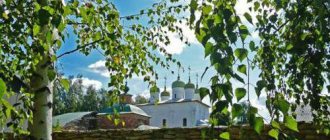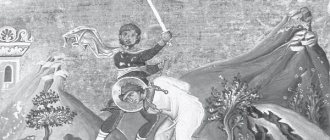- Full name: Church of the Descent of the Holy Spirit at the Danilovskoye Cemetery
- Short names among the people: Temple of the Spirits / Temple of the Holy Spirit, Church of the Holy Spirit, Temple of the Descent on Danilovsky, temple at the Danilovsky Cemetery
- Belongs to the Southern Vicariate, Danilovsky Deanery
- Rector: Archpriest Gennady (Borozdin)
- Famous clerics: Father John (Slugin), who had the gift of clairvoyance. Died February 2, 2022
- Nearest metro station: Tulskaya
- You can order services: funeral service, memorial service, magpie, notes of repose
The temple was built in the 30s. XIX century according to the project of the architect. F. M. Shestakova in the style of classicism. During the years of Soviet power it was not closed, which is why Blessed Matrona of Moscow bequeathed to bury herself at the Danilovsky cemetery. The church operates a Sunday school, a library, an Orthodox creative studio, a children's puppet theater, and a service for helping those dependent on drug addiction and alcoholism.
Scheme of Danilovsky cemetery
Telephone
8
In the church you can submit requests and hold services for seriously ill people and those near death:
- unction
- confession
- communion at home, in hospital
Funeral Orthodox set:
A funeral veil (shroud), a halo on the head, a pectoral cross, a cross in the hand, a piece of paper with a prayer of permission, an eight-pointed gravestone cross.
Ritual.ru will help you order requirements and services when organizing a funeral:
- Funeral service in church and at home, funeral service in absentia
- Memorial service
- Sorokoust
- Notes of repose
Funeral service in church - average donation size
According to an established tradition, a feasible voluntary donation is made for the funeral service - usually in the amount of 2-5 thousand rubles.
Memorial service in the temple - donation amount
usually up to 500 rubles.
Temple of the Descent of the Holy Spirit at Danilovskoye Cemetery
The history of the temple in honor of the Descent of the Holy Spirit at the Danilovsky cemetery in Moscow goes back to the distant 18th century. In 1770, the capital was struck by a serious disaster - a plague epidemic. On September 21, 1771, Empress Catherine II, in her Imperial manifesto, announced the sending to Moscow of Count Grigory Orlov, chosen “for his well-known zeal and loyalty to us and the Fatherland.” The influential favorite of the Empress was given “full power,” all institutions had to obey him, he “had entry” into the Moscow departments and knew the will of the Empress, “to stop, with all the mortal strength he could muster, the destruction of the human race”... Grigory Orlov, by personal decree of Catherine II , ordered the opening of several new city cemeteries away from the walls of the then densely populated Moscow. One of them appeared on the territory of the settlement of the ancient Danilov Monastery. This is where the name of the current Danilovsky cemetery originates. In 1772, for the needs of the cemetery and nearby settlements, a small wooden church was built in honor of the Kherson martyrs Vasily, Ephraim, Kapiton, Eugene, Epherius, Elpidiy, Agathodorus. Over time, the building became quite dilapidated, therefore, at the expense of the eminent Moscow merchants - the Solodovnikovs, Golofteevs, Lepeshkins, Zubovs and others - a new stone temple was erected. Construction lasted 9 years: from 1829 to 1838. The new church was designed by the famous architect of the Moscow classicism era F. M. Shestakov. In 1832, the temple at the Danilovsky cemetery was consecrated. The main altar is in honor of the Descent of the Holy Spirit, and the second was left in honor of the holy martyrs of Kherson (Chersonese). The inside of the new church is lavishly decorated with rich wall paintings depicting biblical scenes: “The Descent of the Holy Spirit”, “The Last Judgment”, etc. In 1901, not far from the temple, the widow of the merchant N.I. Grebensky, in memory of her husband, built a small memorial over his grave church-chapel in honor of St. Nicholas of Myra. It was consecrated in 1902 and is still used today as a chapel. At the beginning of the 20th century, the Church of the Descent of the Holy Spirit was noticeably transformed. “In 1901, the Church of the Descent of the Holy Spirit at the Danilovsky Cemetery was magnificently decorated by the diligence of the ktitor I.Ya. Chernov and benefactors. The temple has a new floor made of multi-colored stone slabs, and the altar is parquet; The iconostasis was again gilded, the paintings on the walls were restored, and all the utensils were restored. The outside of the church was also repaired and painted with oil paint,” Moscow Church Gazette, 1901. In 1905, the southern chapel of the Holy Martyrs of Chersonesos, previously located in the refectory, was expanded, and after perestroika it was placed next to the main altar. At the same time, the temple almost doubled in size, the altars of the main and southern aisles were located next to each other. The new apse almost exactly repeated the size and shape of the apse of the main temple, and the wall of the southern aisle repeated the architecture of the temple wall. The former outer wall was cut through by large arches, and the space of the temple became almost unified. The only thing that was not repeated in the southern aisle was the chapter, which was not placed above the aisle. The temple was one of the few that was not closed during Soviet times and was not destroyed. In Soviet times, the revered icons of the Mother of God “Iverskaya” and “Quick to Hear” were moved from closed churches. Shrines of the temple:
Icon of the Mother of God of Iveron; icon of the Mother of God “Quick to Hear”; icons with particles of the relics of St. Seraphim of Sarov, Blessed Matrona of Moscow and St. Aristocleus of Athos; there is an ark with the holy relics of saints of God.
Plague and Muslims
The Moscow Danilovskoe cemetery was opened at the end of the 18th century near the settlement of Danilovskaya Sloboda near the monastery of the same name. Industrial production began to be built around the settlement, whose workers subsequently contributed to the development of the revolutionary movement.
The Danilovskoe cemetery became famous for the fact that at the height of the plague epidemic, up to eight hundred people who died from this terrible disease were buried there per day. Plague burials were located in the central area. Nearby, the slope of the Andreevsky ravine was given over to the graves of Muslims and representatives of other religions.
Address of the Danilovsky necropolis:
4th Roshchinsky proezd, ow. 30, Moscow, 115191 Contacts:
8 (499) 410-00-00
Danilovskoye Cemetery: opening hours
Summer visits (May-September): 9:00-19:00 Winter visits (October-April): 9:00-17:00 Funeral: 9:00-19:00 17:00 No days off.
How to get to Danilovskoye Cemetery
Tram 38 from Tulskaya metro station Buses No. 41, No. 121, No. 826
Route by car:
TTR → Exit to Dukhovskoy Lane → Entrance to the necropolis
If you are lost, you can ask any passerby where the Danilovskaya cemetery is - he will tell you, because... this is a very famous place in the area. You can also use the navigator, Yandex. Maps or Google Maps on your smartphone.
Is it possible to buy a grave or cell at the Danilovsky cemetery
The burial is closed, so you cannot buy a separate grave. It is possible to find a place through a state auction for a family grave. Or bury a relative in a family grave that has already been purchased in advance. You can also buy a cell in a columbarium
Story
At the end of the eighteenth century, a terrible plague came to the capital. The infection appeared in the Lifortovo hospital. Up to a thousand people began to die from this disease every day. People were in panic, the authorities did not know what to do. Empress Catherine the Second sends Count Orlov to Moscow with unlimited powers. Departments had to obey him unquestioningly.
The count issued a special order to open several burial sites far from the capital. One of them was the territory of the former Danilovsky Monastery, hence the name Danilovskoye. Famous merchants, townspeople, artisans and other famous people were buried there. The merchant family of the Tretyakovs, the founders of the Tretyakov Gallery, Blessed Matrona and Metropolitan Piritima found their final refuge here.
In the late nineties, the remains of St. Matrona were moved to the Intercession Church, but people come to the grave nowadays and bring her favorite chrysanthemum flowers. A small wooden temple was also built for the needs of the population. Over time, this building fell into disrepair after fifty years and a new church made of stone was erected with the funds of the merchants Solodovnikov, Golofteev, Zubov and Lepeshkin.
The architect was the famous in his time Shestakov, an adherent of Russian classicism, he had a light hand, all his buildings have been preserved to this day.
At the beginning of the twentieth century, the church was transformed. It had a floor covering made of multi-colored slabs, and the altar had a parquet floor. The temple has a happy destiny; it was not closed during the period of pressure on believers of the last century. But after the revolution of the seventeenth year, gold and silver church decorations were requisitioned from it.
Dear brothers and sisters! We invite you to visit the unique resource https://www.slovo-pomoshi.ru/. With its help, you can convey your aspirations to St. Petersburg churches, chapels, monasteries, and also contact the righteous at the place of their burial. We will write a note ourselves, take it to the temple and send you a photo report by email. Turning to God with the help of prayers has helped many people overcome grief, regain health and the joy of worldly life.
Useful articles:
“COMMANDMENTS” OF ANNA ROMASHKO, A MOTHER OF MANY CHILDREN 1) Do not complicate your life with many worries. 2) Love everyone who is around the children. Always thank those who help us raise and educate them. 3) Don’t be vain and vain, don’t chase success, don’t demand achievements from your child. 4) Teach yourself and your children to bring... Read more
“10 interesting facts about St. Spyridon” On October 30, the Greek delegation of the Orthodox Church brought to Kyiv a gift to Orthodox Christians - an icon of St. Spyridon of Trimifunt and a shoe from the holy relics of the saint. Let us present interesting facts about Saint Spyridon of Trimythous.1. Reverend all his life... Read more
SHE DOES SMOKE! About how a smoking old woman turned out to be a subdeacon. Two years ago I was invited to confess and give communion to an old woman who was preparing to die. When we were already approaching the house where she lived, the relatives accompanying me somehow hesitated and timidly said: “Father, you know, she smokes with us.” “Well,” I answered... Read more
Do not offend your priests. Look at how Jews and Arabs treat their clergy. Nobody spoils their priests. Jews know that rabbis are just as much lechers, bribe-takers, drunkards and gluttons as everyone else. But not a single Jew would say something nasty about his rabbi. Not a single Muslim will... Read more
Must read: St. Elisabeth Monastery Minsk
Clergy
Abbots
- …
- Nikita Skvortsov (1857 - ca. 1892)
- Vladimir Ostroukhov (1901 - 1914)
- Nikolai Skvortsov (August 9, 1914 - June 15, 1917)
- Ilya Gumilevsky (1922 - ?)
- Sschmch. Ioann Smirnov (1925 - 1932)
- Ioann Mazov (June 14, 1991 - August 23, 1994)
- Sergiy (Rybko) (since 1994)
1932 - 1991 - closure and desecration
Priests
- Alexy Mirolyubov (1901 - 1917)
- Alexy Sokolov (1901 - 1917)
- Alexander Sokolov (1909 - 1917)
- Sschmch. Ioann Smirnov (1923 - 1925)
- Alexy Strakhov (1921 - 1927)
- Alexey (mentioned ca. 1927)
Deacons
- Dimitry Rumyantsev (1901 - 1917)
- Alexy Saryevsky (1913 - 1917)
- Feodor Smirnov (November 16, 1917 - 1932)
- John Ovsyanko (1927) protodeacon
- Mikhail Pirogov (1927) protodeacon
Temple
The Danilovskoe cemetery was founded in 1771 for the burial of those who died from the plague epidemic, which claimed several thousand lives that year. Named after the Danilovsky Monastery located nearby. Next year, a small wooden church was built for the funeral service of the newly deceased. After 50 years it has fallen into disrepair. Therefore, in 1829, construction began on a new stone church. The church was erected under the leadership of the architect Fyodor Mikhailovich Shestakov. All the establishments that he built or rebuilt have survived to this day.
Money for construction was allocated by a well-known philanthropist, Moscow merchant Semyon Loginovich Lepeshkin, with the participation of other donors.
The great consecration of the temple took place in September 1838 . The central altar was dedicated to the Descent of the Holy Spirit on the Apostles. And the border erected in one line with it in honor of the martyrs of Chersonesos. The color of the iconostases is deep green, the color of the Holy Trinity holiday. Gold trim gives the iconostasis a solemn appearance. The wall paintings are made from a combination of decorative paintings and evangelical scenes. Nothing has changed in this part since its construction and consecration. The decoration of the temple remained in its original form, only slightly darkened by time. And worthy of all attention.
The architecture of the temple belongs to the Empire style. You can't call him smart. It is practically devoid of decoration. Strict, monumental forms perfectly suit the place and purpose of his ministry.
The temple has never been closed since its construction and consecration. In the 30s it was captured by renovationists. But in 1941, before the evacuation from Moscow, then Metropolitan Sergius of Stragorodsky appointed him honorary rector of Archbishop Alexei Palitsin. We must assume that the temple already belonged to the Orthodox Church.
In 1905, the southern limit was expanded and the bell tower was reconstructed. Later, ancient images were transported here from the ruined and closed St. Simon's Monastery:
Mother of God Quick to Hear; Iveron; St. Seraphim of Sarov; Alexander Nevsky.
A real masterpiece of church art is the iconostasis of the mother of the Most Holy Theotokos - Righteous Anna. The main element of the iconostasis is a cross, from which life-giving rays emerge, carrying the truth of salvation and color to all things. The traditional image of the Annunciation on the royal doors is illuminated by this unearthly light and at the same time is part of this light.
Anyone entering the temple is greeted by a large image of Calvary with the crucified Christ, the grieving Mary Magdalene and the view of the doomed Jerusalem. In front of the crucifix there is a canon on which candles are placed to commemorate the dead.
For a long time, there has been an ark in the temple with particles of the relics of the saints of God . But whose exact relics rest there is unknown even to the old-timers. The list with the names of saints was lost a long time ago.
Archpriest John (Slugin) serves in the church. Father John has the gift of foresight. He is very old. Takes little. It is better to call the temple in advance.
